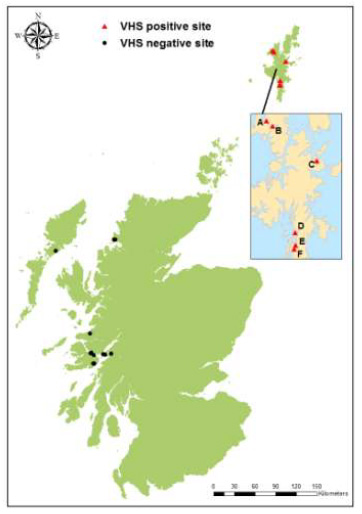Scottish Marine and Freshwater Science Volume 4 Number 3: Epidemiology and Control of an Outbreak of Viral Haemorrhagic Septicaemia in Wrasse Around Shetland Commencing 2012
Report on an outbreak of viral haemorrhagic septicaemia in multiple stocked species of wrasse on six sea-water sites around Shetland Mainland commencing December 2012.
4 Geographical Distribution of VHS
All six sites stocking wrasse around Shetland were positive for VHS. The sites were in three disparate localities (Figure 1) comprising south-west Shetland mainland (three sites), north-west Shetland Mainland (two sites), and east Shetland mainland (one site). All tested sites stocking wrasse out-with Shetland were negative for VHS (Figure 1). There appears to be a cluster of VHS positive sites around Shetland.

Figure 1. Location of VHS positive and negative sites
A spatial analysis utilising a Bernoulli model and a circular scanning window of variable radius, with p-values calculated by comparing the rank of the likelihood of the most likely cluster to the ranks of the likelihoods of datasets for which the VHS status of sites is randomised [14] , was carried out using the specialist software SaTScan tm (version 9.1.1) [15] . The most likely cluster, which includes all VHS positive sites around Shetland and no VHS positive sites elsewhere, can be regarded as statistically very highly significant (p<0.001). In conclusion, the cluster of VHS positive sites around Shetland has statistical support.
Contact
There is a problem
Thanks for your feedback